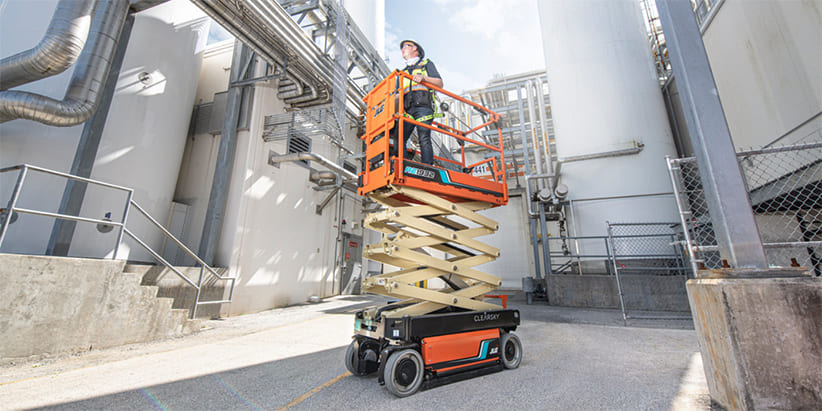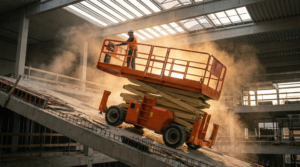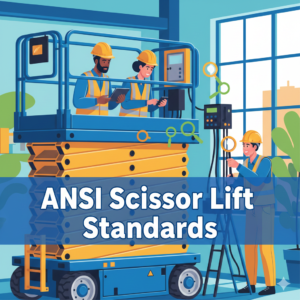Scissor lifts, a type of Mobile Elevating Work Platform (MEWP), have come a long way since their inception in the 1960s. Over the years, these essential tools for elevating workers and materials have undergone remarkable advancements, adapting to the changing demands of various industries. In this article, we will delve into the evolution of scissor lifts, exploring their history, the latest advancements in technology, and future trends that promise to revolutionise the industry.
The Evolution of Scissor Lifts
Scissor lifts owe their existence to the broader development of hydraulic lifts in the 1920s. However, it wasn’t until 1966 that the scissor lift, as we know it today, was developed. From its humble beginnings, scissor lifts have witnessed significant transformations in several key areas.
Height Reach
One of the most noticeable advancements in scissor lift technology has been the increase in height reach. In the 1990s, scissor lifts broke the 25-foot barrier for the first time. Today, modern scissor lifts effortlessly reach heights ranging from 20 to an impressive 60 feet, making them indispensable for various facilities management, construction, maintenance, and warehousing applications.
Fuel Source Diversification
Scissor lifts have also evolved in terms of their power sources. In the early 2000s, hybrid scissor lifts made their debut, providing a more diverse range of fuel options. These hybrid lifts combine the benefits of electric and traditional oil-based power sources. The trend toward sustainability has driven the adoption of hybrid and electric scissor lifts, reducing carbon footprints and minimising environmental impact.
Electric Scissor Lifts: The Eco-Friendly Alternative
Electric scissor lifts have gained significant popularity due to their environmental friendliness. Powered solely by electricity, they eliminate the need for fossil fuels like diesel. Electric scissor lifts offer extended battery life compared to their oil-fueled counterparts, reducing maintenance and replacement costs.
Moreover, electric scissor lifts are remarkably quiet, making them ideal for indoor use and other noise-sensitive environments. They are also well-suited for cold conditions, as they are not susceptible to oil viscosity issues associated with lower temperatures. Additionally, electric scissor lifts eliminate concerns about oil leaks, providing a cleaner and safer working environment.
Hybrid Scissor Lifts: Combining Power Sources
While electric scissor lifts offer eco-friendliness, traditional oil-based lifts still have their advantages, such as greater power and load capacity. Hybrid scissor lifts, also known as bi-fuel scissor lifts, bridge this gap by allowing operators to switch to oil-based fuel when necessary, all while maintaining a reduced carbon footprint.
Smart Controls and Automation in Scissor Lifts
Scissor lifts are embracing the era of smart controls and automation. Innovative battery management systems enable operators to monitor charge levels and usage more effectively. Solid state controls are another exciting development, offering several benefits:
- Instant fault code diagnostics.
- Improved horsepower management.
- Easy configuration for various job sites.
- Softer stops for operator comfort.
- Simplified software and hardware updates.
- Smartphone connectivity for remote diagnostics.
Telematics, a rapidly emerging technology, is poised to become a standard feature in scissor lifts. Telematic control systems provide remote access to vehicle data and controls, offering numerous benefits for both service providers and customers.
Learn More: 15 AERIAL LIFT SAFETY TIPS FOR OPERATORS, MANAGERS, AND PEDESTRIANS
Enhanced Safety Features for Scissor Lifts
With working from height presenting several risks, safety remains paramount in scissor lift technology. Several features have been developed to mitigate risks associated with working at height.
Pothole Protection System
Potholes can pose a significant risk to scissor lift operators. When a scissor lift passes over a pothole, it can result in an abrupt jolt, potentially causing injury. To address this, modern scissor lifts are equipped with pothole protection systems that lower the machine’s ground clearance when elevated, reducing the risk of accidents caused by uneven terrain.
Service Diagnostic Tools
Service diagnostic tools have become essential for monitoring critical components, quickly identifying malfunctions, and reducing service downtime. These tools enable technicians to pinpoint issues efficiently, ensuring that the scissor lift can be safely and swiftly returned to operation.
Load Sensing System
To prevent overloading, which can lead to instability and tipping, scissor lifts now incorporate load sensing systems. These systems measure the weight of the load using force-based or pressure-based methods, ensuring that the lift operates within safe load limits.
Variable Tilt Technology
Variable tilt technology enables scissor lifts to operate safely on slopes of up to three degrees. Sophisticated sensors measure the machine’s slope, platform load, and height, comparing these data points to maximum safe operating limits. This technology enhances the versatility of scissor lifts across various terrains and inclines.
Compact and All-Terrain Scissor Lifts
As the demand for scissor lifts has grown, their designs have adapted to accommodate diverse environments. Two notable innovations are compact and all-terrain scissor lifts.
Compact Scissor Lifts
Compact scissor lifts are designed for use in tight spaces, making them ideal for warehouses and residential settings. These machines have limited height reach but can navigate through narrow doorways that traditional scissor lifts cannot.
All-Terrain Scissor Lifts
Also known as rough terrain scissor lifts, these machines are engineered to handle uneven outdoor surfaces commonly encountered in construction, quarrying, landscaping, mining, and event setup. Equipped with puncture-protected rough terrain tires, extendable stabilisers, and four-wheel drive capability, all-terrain scissor lifts can tackle challenging terrain, including slopes of up to 40% gradability.
Future Trends in Scissor Lift Technology
As the scissor lift industry continues to grow, several exciting trends are shaping its future.
Enhanced Telematics on Access Platforms
Telematics is expected to play an increasingly significant role in scissor lift technology. The ability to remotely monitor, track, and control scissor lifts offers tremendous efficiency, safety, and cost-reduction benefits. With continuous advancements in telematics, we can expect even more sophisticated features and integration with other construction equipment.
Green Scissor Lift Technology
The global push for sustainability will drive the development of greener scissor lift options. Expect to see advancements in electric and hybrid technology and the exploration of alternative fuels such as hydrogen. These innovations will reduce environmental impact and provide cost-saving benefits to businesses.
Automation and Robotics for MEWPs
Automation and robotics are poised to transform scissor lift operations further. Automated scissor lifts equipped with advanced sensors and machine-learning algorithms will enhance safety, increase efficiency, and reduce the need for human intervention. These robotic lifts will excel in tasks requiring precision and repetitive actions.
Enhanced Scissor Lift Safety Systems
Safety will remain a top priority, with continued improvements in safety features and systems. Innovations may include even more advanced collision avoidance systems, enhanced fall protection measures, and integrated safety training modules to ensure that operators are adequately prepared for their tasks.
Learn more: ELECTRIC POWERED SCISSOR LIFTS: THE PROS AND CONS
Conclusion
By understanding the evolution and future trends of scissor lifts, businesses can make informed decisions to improve their operations, enhance safety, and embrace sustainability. Scissor lifts have come a long way since their inception, and their continuous advancements promise a future of increased efficiency and safety in various industries.





